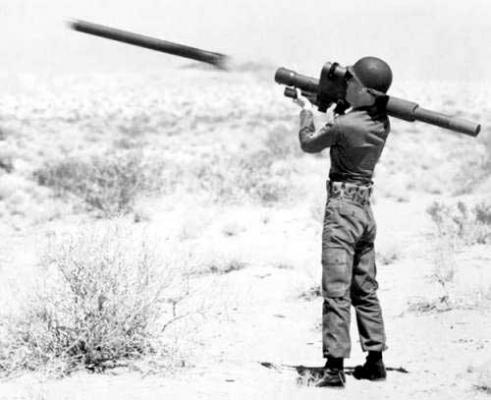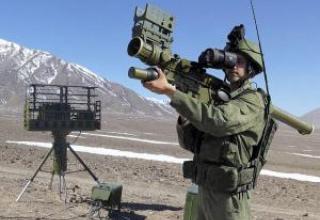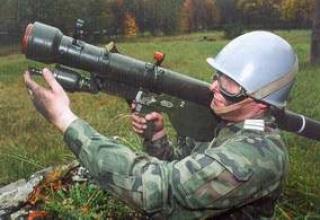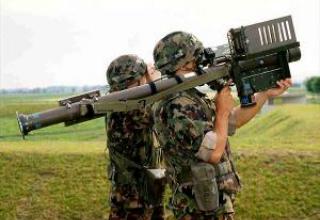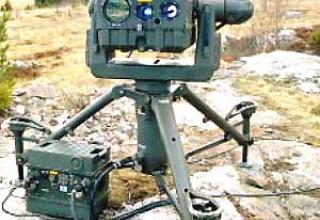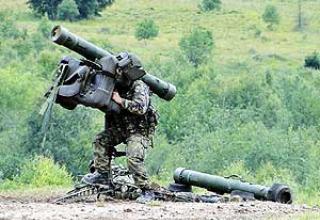Portable anti-aircraft missile system (MANPADS) FIM-43 "Redeye" is designed to hit the catch-up courses of aircraft and helicopters flying at low and extremely low altitudes.
The development of a prototype of a lightweight man-portable anti-aircraft missile system designed for self-defense of military units on the battlefield, was initiated by the American company "Convair" in 1955. The first results of these developments were presented to the U.S. Department of Defense in November 1956. Full-scale work to create a new complex, called "Redeye", began in April 1958. Two years later, flight tests began, and December 14, 1962 was first struck by an air target QF-9F, flying at an altitude of 300 meters at a speed of 450 km / h.
The world's first man-portable air defence system, the Redeye Block I (XMIM-43A), was adopted in 1965. The development of an advanced version of the "Redeye" Block II (XMIM-43B) began in 1964 and already in April 1966, it was released for testing. Block II differed from the prototype by having a cooled homing head, an advanced combat unit and a trigger device. In 1966, the Redeye complex received a new designation - FIM-43. The process of improving the complex continued and in March 1968 the U.S. Army and Marine Corps received a new version - "Redeye" Block III (FIM-43C).
A number of serious shortcomings of the "Redeye" complex, revealed in the process of operation, stimulated the beginning of development in 1972 of a new generation portable anti-aircraft complex, which was named "Stinger". Production of "Redeye" complex was completed in 1969. - In total more than 85000 copies were produced. The man-portable air defense system "Redeye" was finally removed from the armament of the American Army in 1995.
The man-portable air defence systems "Redeye" of various modifications were adopted by the armies of 24 countries, including: Germany, Sweden, Denmark, Austria, the Netherlands, Israel, Jordan, Saudi Arabia, Sudan, Thailand, Turkey, etc.
Composition:
The Redeye is a portable anti-aircraft missile system:
- starting device with telescope sight and power supply;
- an anti-aircraft guided missile FIM-43 in a transport and launch container.
The starter unit combines all the elements required to start the LSD (see layout diagram). When preparing the complex for combat, it is connected to the transport and launch container with the missile. The FIM-43 missile is a single-stage, aerodynamic "duck" rocket. The propulsion system - solid fuel, consisting of the launch and marching engines. The rocket was equipped with a homing thermal head (TGSN), cooled by freon. The TGSN detector is made of sulfur lead. Target search and its tracking were made by means of 2,5-fold optical sight with 25° viewing angle. Fuses - contact and non-contact. The target was hit by a shrapnel-flag warhead (BC) with a mass of about 1 kg, with the explosive mass varying from 0.56 to 0.7 kg, depending on the modification. From the inside, the two-layer hull of the BC had the planned crushing flow, with which the explosion produced 80 15-gram fragments, flying at a speed up to 900 m/s.
The complex is designed to engage low-flying air targets in good visibility conditions. Shots are fired only at catch-up courses. To engage an air target, the operator prepares the system for firing (switches the fuse to the combat position), grips the target in the optical sight and follows it. As soon as the infrared radiation from the target is detected by the ZAR's homing head receiver, visual and audible indicators are triggered to capture the target. The operator, while continuing to monitor the target through the sight, determines to the eye the moment it enters the starting area and presses the trigger. This is followed by the ZUR's onboard power supply, and the starting charge of the propulsion system is ignited. The rocket leaves the launch tube and at a distance of 4.5-7.5 m the marching engine charge ignites. The total preparation time of the SAM for launch takes about 6s, the battery life - 40s. In case of miss, the missile self-liquidation takes place.
The target acquisition range of the homing head depends on the target radiation power and, for example, for a tactical fighter is about 8 km. The probability of hitting a non-manoeuvring target with a single missile is 0.3-0.5. There is no equipment for identification of nationality.
The main disadvantages of the "Redeye" complex are:
- the possibility of firing only at the rear hemisphere of the target,
- low noise immunity of the TGSN, which allowed the missile to be driven off course with the help of thermal traps,
- the telescope sight is not wide enough,
- short battery life - as a result, inexperienced operators did not always fit in the interval between target detection and missile launch.
The main combat unit of man-portable air defence systems "Redeye" in the U.S. Army is a firing squad consisting of two men: the shooter-operator and his assistant.
Variants of the complex:
- "Redeye" Block I (XMIM-43A/FIM-43A). Complete with XM147 trigger with XM59 telescope sight. The FIM-43A had the XM45 fragmentation and XM804 contact fuse. The range of enemy aircraft from 0.5 to 3.5 km, with a maximum target speed of 230 m / s. Altitude range - from 30 to 1500 m.
- "Redeye" Block II (XMIM-43B/FIM-43B). The upgraded version differs from the FIM-43A by an improved launch device - XM147E1 with a new cooling system TGSN missile. The missile is equipped with a more powerful BC - XM45E1.
- "Redeye" Block III (FIM-43C). FIM-43C rocket is equipped with a new propulsion system M115, combat unit M222 (weight 1.06 kg) and a new fuse M814. Atlantic Research's dual-mode M115 solid fuel engine provides 3.3KN thrust for 0.048s in the launch mode and 1.1KN for 5.8s on the march. The XM171 launcher was equipped with a new XM62 scope and advanced electronics to interface with an upgraded missile. The FIM-43C has an extended range of up to 4500m and a ceiling of up to 2740m, can maneuver with an overload of up to 3g and provides a "fighter" type target probability of 0.4.
Characteristics:
| Defeat zone: - in range, m - in height, m |
4500 0.05 - 2700 |
| Rocket: - length, mm - body diameter, mm - wingspan, mm - starting weight, kg - flight speed,m/sec |
1200 70 140 8.3 1.7М |
Testing:
Man-portable air defence systems "Redeye" were actively used by Afghan mujahideen against Soviet aviation during the Afghan war. In the course of combat operations it was revealed that the capture of TGSN missiles of helicopters without EVUs is possible at a distance not exceeding 1.5 km, and with the device - only 1 km. The firing of thermal traps almost always took these missiles off course, and the installation on the helicopters stations of pulse IR interference LVV166 "Lipa" reduced the probability of hitting the FIM-43 SAM system to almost zero. It also turned out that both types of missile fuses were not reliable. Cases have been recorded in which the Redeye flew several centimetres away from the helicopter body without breaking, and in a direct hit it crashed on the armour or got stuck in the dural.
In just 1982-86, the Mujahideen using the Redeye man-portable air defence system shot down two Mi-24Ds and one Su-25. In one case, the missile hit the NAR UB 32-24 unit and detonated the rocket. The crew was killed. The second SAM hit the stern, causing a fire. Two more rockets struck the flames, hitting the helicopter at the root of the wing and the gearbox. The car lost control and crashed. And in this case, no one from the crew survived.
In some cases, the enemy managed to damage several Mi-24. Thus, June 23, 1984 Mi-24V k-on V.Smirnov was fired by twelve ZUR "Redeye". One rocket crashed and did not explode, another broke a hole in the EVU, the third exploded on the engine armored plate, without causing serious damage, the fuse of the fourth went off at the stern of the helicopter, causing a fuel leak and fire. Then dushmans fired seven more of these rockets, but the pilot shot off the thermo-trap, and all the ZUR went into the "milk"! The damaged Mi-24 reached his airfield and was soon returned to service. In March 1985, a single rocket hit the Mi-24, but the crew managed to cope with the situation and made a mild forced landing. In another case, two Redeyes hit the armored hood of the gearbox, bending and plunging it. Repair was limited to installing a new hood. In the end, the "warriors of Allah" themselves refused to use the FIM-43. Perhaps the only advantage of the missile was a sufficiently strong striking BC, provided by a powerful blast effect, supplemented by heavy fragments.
The effectiveness of man-portable air defense systems "Redeye" on the Mi-8 helicopters was higher, although experience of combat operations showed that even in this case the probability of hitting was 30% lower than that of "Arrow-2".
Sources:
- General Dynamics FIM-43 Redeye
- Шунков В.Н. "Ракетное оружие" .-Мн.: ООО "Попурри", 2001- 528с.


